Written 28 February 2023
David and I set off in different directions in Nuremberg: I took a morning tour of the "art bunkers" and an afternoon tour that included baking lebkuchen. David held out for the afternoon World War II tour.
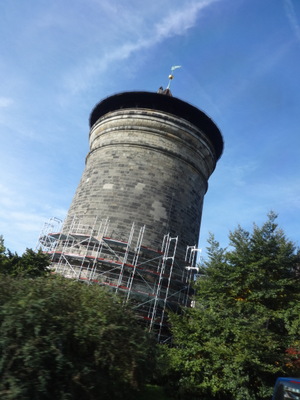
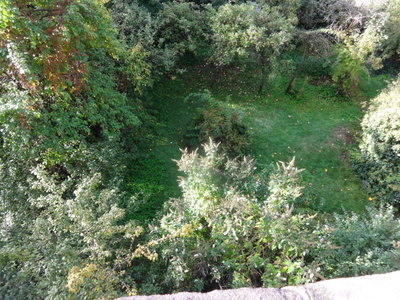 The ship was moored some way out of town (the Danube doesn't actually pass through Nuremberg), so we rode the bus (with guide Patrick and driver Dieter) through a fair amount of modern suburb on our way to the center of things.
The ship was moored some way out of town (the Danube doesn't actually pass through Nuremberg), so we rode the bus (with guide Patrick and driver Dieter) through a fair amount of modern suburb on our way to the center of things.
"Nurem" (or Nürm, as it's spelled in German) means "stony" or "rocky," and "berg" means mountain. The city got its name because it's built on a huge, more or less solid, 215-million-year-old sandstone rock. The city wall took 100 years to build. We accordingly spiraled up to it around the sides that that rock.
In the left-hand photo is one of a series old stone towers that were further reinforced to withstand bombing and served as shelters during WWII. Some of them were for people, but one was reserved for documents.
At the right is the view down from one part of the spiral to a lower level. That area is now a lovely pedestrian park, but I think the guide said it once housed a zoo. (The modern zoo is elsewhere.)
As usual, our guide spent the bus ride telling us all about Nuremberg and in particular about its WWII experiences. Unfortunately, my recorded notes from that ride turned out to be largely inaudible when I tried to transcribe them, so I've captured only fragments:
Aerial aerial warfare apparently featured largely; Patrick mentioned both zeppelin bombing and airplane bombing, as well as the relationship between Germay and General Franco of Spain. He showed us a large block of brick buildings were intended as German barracks but wound up serving only as American barracks during the postwar occupation. I think he said 39 German bombing raids were carried out against London, and that the allied bombing was inefficient, since 66% of German industrial capacity remained functional at the end of the war.
He talked at great length about "moral bombing," and I had trouble puzzling out what he meant by it. Bombing only of military targets? But that didn't seem to fit with what he was describing. Eventually I figured out that he actually meant "morale bombing," like the London blitz, intended to break the enemy's morale. The allies did some of it, too, and it doesn't seem to have worked for either side.
Nurmberg was essentially leveled, especially the old, inner city. The most devastating attack against it was January 2, 1945. By the end of the war, it had suffered the second worst destruction after Dresden. American troops were the ones to take Nuremberg, in 1945.
Fortunately, on our arrival at the city and disembarkation from the bus, my notes became audible once more.
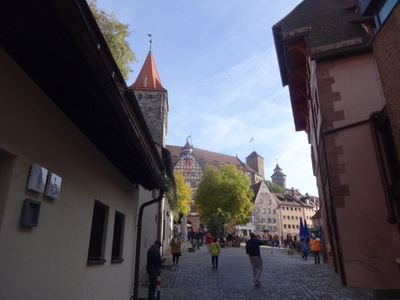
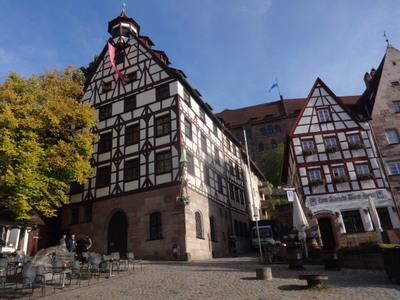 Here are a couple of photos from the central market square of the old town. Keep in mind that this area was just rubble in 1945.
Here are a couple of photos from the central market square of the old town. Keep in mind that this area was just rubble in 1945.
What we had come to see here, though, was the art bunkers. The story starts early in the town's history. The water wasn't safe to drink; 40,000 people lived within the walls (only about 33,000 today), and the sewage went straight into the little river that flowed through town (as did the offal from the meat market). Germans were slow to realize that you could boil water to make it safe to drink, so they drank beer instead, and at a couple liters per day per person, that took a lot of beer production. Further, the local beer was bottom-fermented at 50 to 60
Early in WWII, Hitler was so sure of German victory, and so certain that allied planes would never even penetrate German air space, that he actually made it illegal to make preparations for air raids or other wartime destruction! But a few influential men in Nuremberg—Dr. Konrad Fries, head of the city’s Air Raid Protection Department; architect Dr. Heinz Schmeissner; and Julius Linke, head of the city’s Monument Preservation Department—weren't so sure and began making preparations in secret to protect the city's artistic treatures.
Among them, they happened to own a couple of good-sized, empty beer cellars, not connected to any others, and they had deep pockets. They set up a functioning antiques shop on the main market square that had a secret entrance in the back to the cellars. The shop served as a perfect cover for people coming and going carrying crates and boxes, furniture and statues. Quietly, they started stashing the city's treasures down there, beginning with the stained glass from the cathedral, packed in wooden boxes. And that's what we got to tour.
Now, this is not the blockbuster cache from Monuments Men, where the little marble Venus from Bruges was hidden—that was in a salt mine in Austria—but it was one of the many stashes they did find, and it safely preserved one whole heap of important art. Other treasures included the oldest song book and the oldest law book in Germany; those are now back in Heidelberg. For complicated historical reasons, for example, the German crown jewels (orb, sceptor, crown, the whole nine yards) were housed in Nuremberg, so down into the cellars they went, where they safely rode out the destruction above, protected by 20 feet of massive sandstone. Initially, only local items were hidden there—municipal art, museum collections, and privately held items hidden with the permission of the owners. They managed to save about 95% of the content of the ciity's museums and churches. But as the war progressed, word leaked out, and the law changed, smaller surrounding towns started sending their own treasures, and eventually the Nazis added looted art. Among those was a collection of art from Poland; the monuments men found it and repatriated it in 1946.
An aside: Somebody (one of the emperors?) had determined that Nuremberg should keep the crown jewels, but in the 18th century, they were all taken to Vienna. When the empire ended, nobody seemed to remember who they belonged to, but in 1938, Hitler brought them here and put them in a bank vault. The monuments men gave them back to Vienna, on the theory that that's where Hitler got them. I'm not sure where they are now . . . Anyway, there's supposedly a photo somewhere of an American GI, with a cigarette in his mouth and a beer in his hand, wearing the crown.
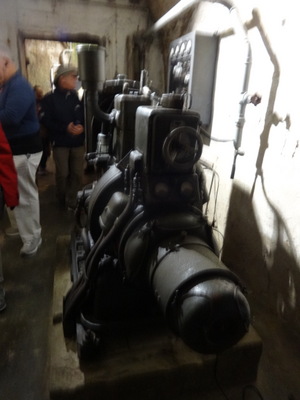
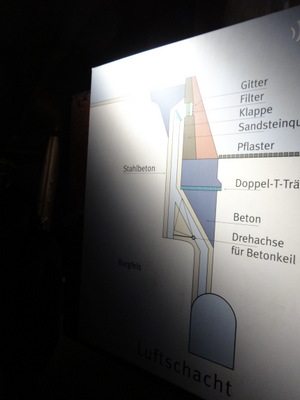 What I found truly amazing was the great care taken with the preparations. I wish I could have gotten better photos. The whole place was heated and air conditioned (making use of the old ventilation shafts from the beer cellars), and the walls of the cells containing the art were carefully waterproofed with layers of tar between brick partitions and wall board. Elaborate filters ensured the purity of the air and water supply.
What I found truly amazing was the great care taken with the preparations. I wish I could have gotten better photos. The whole place was heated and air conditioned (making use of the old ventilation shafts from the beer cellars), and the walls of the cells containing the art were carefully waterproofed with layers of tar between brick partitions and wall board. Elaborate filters ensured the purity of the air and water supply.
A 13-hp generator provided electrical power for lights and HVAC in case the city grid failed, and a 12th century cistern was brought back into use to supply water in case the city's water supply failed (the compressors were water-cooled).
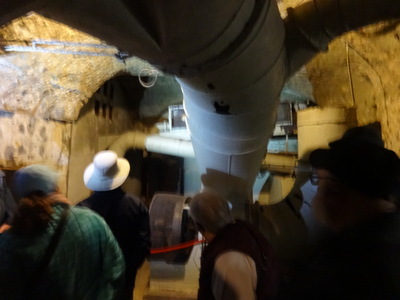
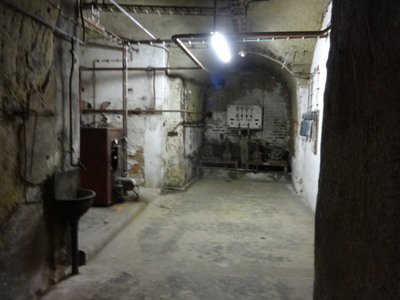 Ducts and electrical conduit ran everywhere through the tunnels, and HVAC could be controlled cell by cell.
Ducts and electrical conduit ran everywhere through the tunnels, and HVAC could be controlled cell by cell.
Batteries were in place to start the diesel engines.
Written 1 March 2023
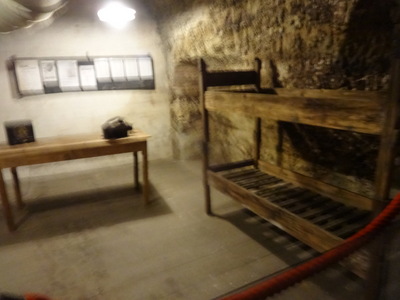
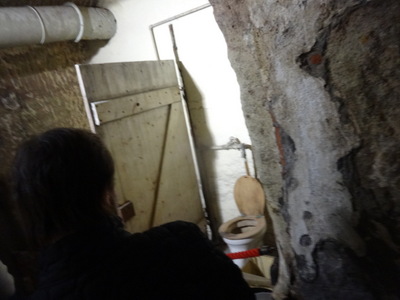 Groups of four armed guards at a time worked 72-hour shifts underground. At the left here is their bunk room, and at the right the latrine, complete with flush toilets and a urinal.
Groups of four armed guards at a time worked 72-hour shifts underground. At the left here is their bunk room, and at the right the latrine, complete with flush toilets and a urinal.
An old bank vault door was used to close off the suite of cells with the most valuable pieces, including the crown jewels, which were brought down, vault and all, from the bank where they were being stored. The guards apparently were not told what they were guarding and did not have the combination to the vault. Only the principals and the lord mayor had access.
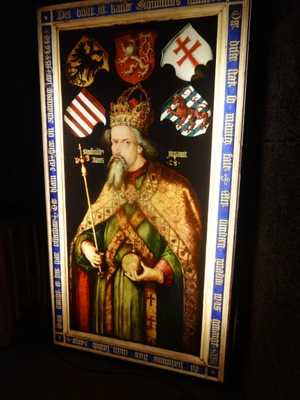
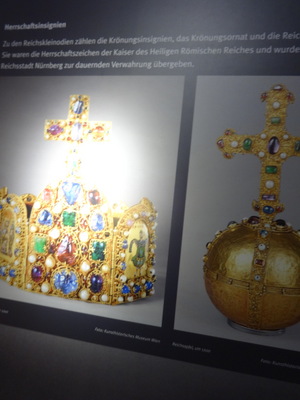 None of the art was still there, but photos of some of it were displayed for tourists like us.
None of the art was still there, but photos of some of it were displayed for tourists like us.
At the left here is a photo of a 1512 painting by Albrecht Dürer of Emperor Sigismind (the only Holy Roman Emperor born in Nuremberg), wearing the regalia (actually that of Bohemia, not the German crown jewels). At the right, a photo of some of the actual stuff locked in a vault within an underground vault here in the tunnels. Note that it got a lot fancier after Sigismund's time.
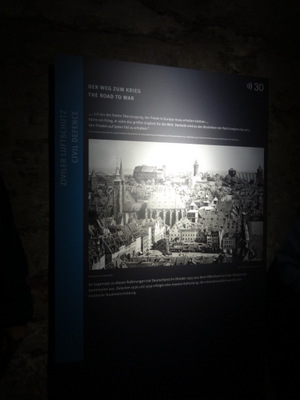
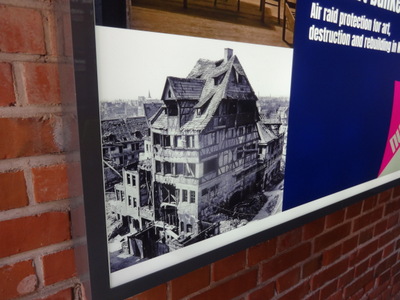 Also displayed in the tunnels were historic photos of the city. At the left is an old photo of the city before the bombing. At the right is one showing damage to one of the half-timbered buildings in the market square.
Also displayed in the tunnels were historic photos of the city. At the left is an old photo of the city before the bombing. At the right is one showing damage to one of the half-timbered buildings in the market square.
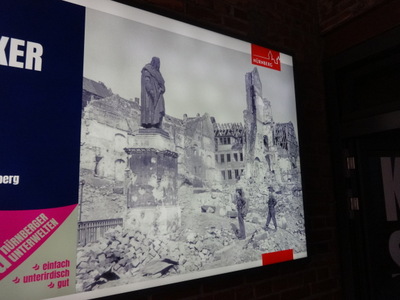
 Meanwhile, preparations were also underway to save immovable monumental art. Albrecht Dürer is a favorite son of the town, and a statue of him stands in the market square, near the 1509 house where he lived on what is now Albrecht Dürer Strasse. The city encased it in a brick and concrete dome, so successfully that, in the photo at the left, showing the market square smashed to rubble, the statue is still there, standing tall, without a scratch on it.
Meanwhile, preparations were also underway to save immovable monumental art. Albrecht Dürer is a favorite son of the town, and a statue of him stands in the market square, near the 1509 house where he lived on what is now Albrecht Dürer Strasse. The city encased it in a brick and concrete dome, so successfully that, in the photo at the left, showing the market square smashed to rubble, the statue is still there, standing tall, without a scratch on it.
The photo at the right is one I took, showing that it's still there, with the square rebuilt around it.
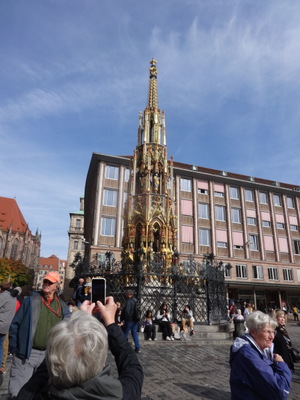
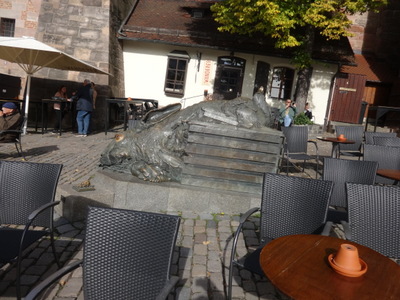 They were able to do the same thing with the "Schöner Brunnen," the 19-m 14th-century gothic fountain, also in the market square. It's visible (though pretty darn small) in the historic "before the bombing" photo above, and the photo at the left shows how it looks today.
They were able to do the same thing with the "Schöner Brunnen," the 19-m 14th-century gothic fountain, also in the market square. It's visible (though pretty darn small) in the historic "before the bombing" photo above, and the photo at the left shows how it looks today.
My favorite feature of the market square, though, is the bronze rabbit shown here at the right. If you've never seen the famous Dürer rabbit, just Google "Durer young hare" (without the quotes). Here in the square in 1984 a modern artist, Jurgen Goertz, placed this spoof/satire/tribute to Dürer. It's a giant bronze hare that has either crushed or burst out of a crate, releasing a bunch of smaller crazed-looking bunnies and apparently crushing a human, whose toes just peak out under one of it's clawed paws. It's been called one of the world's ugliest pieces of public art, but I love it! (In the right-hand member of the second pair of photos on this page, you can just make it out among a cluster of iron chairs and right in front of a trio of bystanders.)
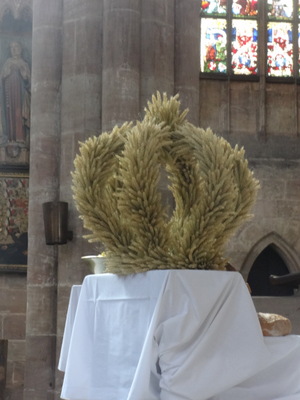
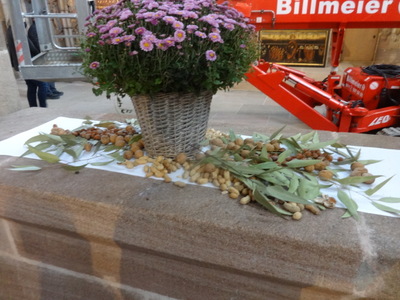 Next on the tour was the church of St. Sebaldus, who is famous for having, one evening in a snowy forest, collected a bunch of icicles and built a bonfire with them.
Next on the tour was the church of St. Sebaldus, who is famous for having, one evening in a snowy forest, collected a bunch of icicles and built a bonfire with them.
I didn't get a good photo of the exterior, but inside they were apparently having some sort of harvest festival featuring this crown made of ears of wheat and this table bearing chrysanthemums and spread with walnuts, hazelnuts, peanuts, and what look to me like eucalyptus branches.
The original church on this site was just a chapel, which was later replaced by a Roman basilica style, then by the church you see today. It was, of course, Catholic. But the reformation was popular here, and the city's population gradually became majority protestant. So one day in the middle of the 16th century, the city council decided it was time. Overnight, they moved the priests out and installed protestant clergy; the council had paid for the original construction and outfitting, so they felt they had the right to make the change. The church has been protestant ever since.
But this wasn't an entirely hostile takeover. They kept the eternel flame and have maintained it ever since. They promised to keep and care for all the original statuary, and they saw that it and the lower stained glass was all moved to the bunkers during WWII. That explains why a protest church is littered with statues of saints and has a crucifix behind the altar rather than a plain cross.
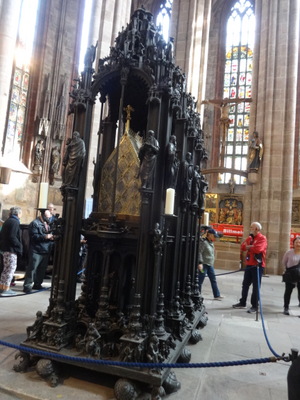
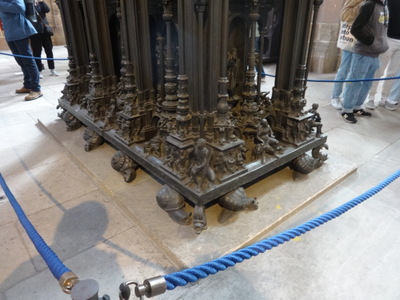 The problem, during the war, was the elaborate tomb of St. Sebaldus himself, right in the middle of the floor. It was made by Peter Vischer the Elder in the early 16th century. It couldn't be moved to the bunkers, so they built a brick enclosure around it and filled the whole thing in with sand, then topped it with a sturdy concrete dome. During the bombing, the entire church fell in, but even though the great stone roof fell right on it, the sand-filled dome held, so the tomb is still in place, undamaged.
The problem, during the war, was the elaborate tomb of St. Sebaldus himself, right in the middle of the floor. It was made by Peter Vischer the Elder in the early 16th century. It couldn't be moved to the bunkers, so they built a brick enclosure around it and filled the whole thing in with sand, then topped it with a sturdy concrete dome. During the bombing, the entire church fell in, but even though the great stone roof fell right on it, the sand-filled dome held, so the tomb is still in place, undamaged.
The right-hand photo is of the base of the tomb. The snails on which it rests symbolize eternity. The protestants stopped short at selling indulgences, but for a while, they did charge Catholic pilgrims for permission to pray at the tomb.
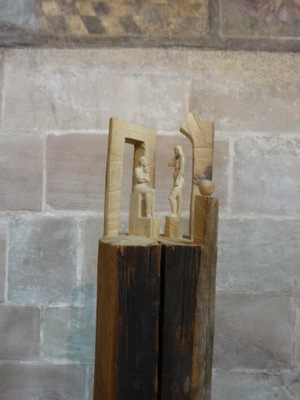
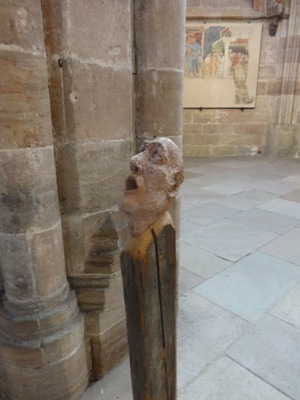 From some wooden structures that couldn't be saved, they took the sacred wood and gave pieces of it to artists. Displayed throughout the church are the small pieces of carved wooden art that resulted.
From some wooden structures that couldn't be saved, they took the sacred wood and gave pieces of it to artists. Displayed throughout the church are the small pieces of carved wooden art that resulted.
St. Sebaldus also houses art that was taken from churches that were destroyed and not reconstructed, as well as a crown of nails made of nails from Coventry Cathedral, which was bombed.
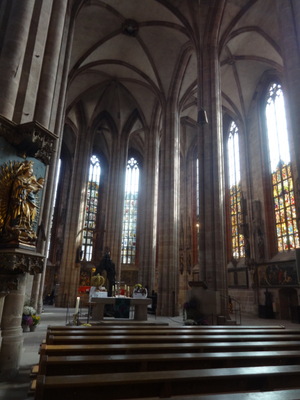
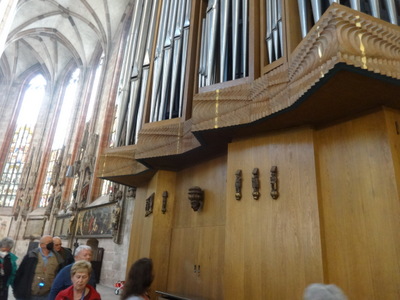 About the lower 8 m of the outer walls remained standing, but the rest of the church had to be rebuilt. They even reopened the original quarries to get the right color of sandstone. This view down the nave shows the stained glass that was stored in the bunkers. The upper parts of the windows were apparently less valuable and are now filled with clear glass.
About the lower 8 m of the outer walls remained standing, but the rest of the church had to be rebuilt. They even reopened the original quarries to get the right color of sandstone. This view down the nave shows the stained glass that was stored in the bunkers. The upper parts of the windows were apparently less valuable and are now filled with clear glass.
The organ dates from 1950; it apparently incorporates a few pieces of the old 1444 organ that were salvaged from the rubble. From 1695 to 1706 Pachelbel played that organ. He's buried here in the city, but most residents have never heard of him. His music was featured in a 1980 movie called Ordinary People, but even that didn't help because it wasn't successful here.
Many, many of the portals and niches remain vacant as they can't afford to have new figures carved to be put in them. Our guide is optimistic about a plan to make them by 3D printing with sand and glue.
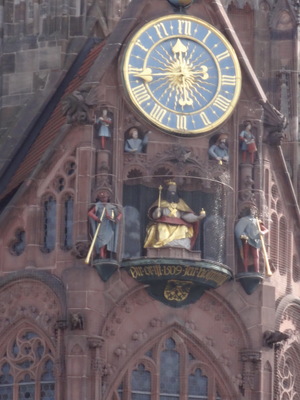
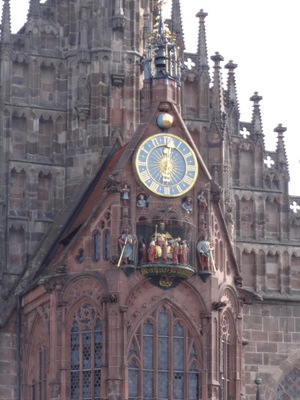 And here is the facade of the Frauenkirche, famous for its mechanical clock. We were there for its noon display. At the left, you can see Charles IV sitting in state, and at the right a few moments later, the prince electors parade before him, more than once. The trumpeters blow, and the bell rings, and a harpist plays. Very impressive!
And here is the facade of the Frauenkirche, famous for its mechanical clock. We were there for its noon display. At the left, you can see Charles IV sitting in state, and at the right a few moments later, the prince electors parade before him, more than once. The trumpeters blow, and the bell rings, and a harpist plays. Very impressive!
Then it was back to the ship for lunch, but of course the flow of information never stops. Here are more things the guide told us on the ride and at various other times.
- Incendiary bombs were particularly nasty, because you couldn't extinguish them for 10 days. The casing was magnesium, which itself burns like fury, and they were filled with a mixture of powdered aluminum and iron oxide, i.e. thermite.
- "Mosquito planes" dropped "Christmas trees," hovering triangular frames holding flares to light things up for the bombers. When the flares showed up, you knew the bombs would be there within 3 minutes.
- Nuremberg was liberated on 23 April 1945.
- Just clearing the debris took years before reconstruction could begin.
- Frankfurt rebuilt in ugly 1950s architecture, but Nuremberg kept and rebuilt its old street plan and mich of its old architecture. They did cheat a little on the street plan to make things a a bit wider, but the houses and shapes of the roofs are the same.
- In one large gap they built a big apartment building, but they reconstructed the roof line of the original houses and made it look like three buildings with interrupted windows.
- The travel crown of the Holy Roman Emperors could be folded.
And the guide shortage must be happening here too. We saw one hapless guide festooned with two lollipops, two mirophones, two headsets, guiding two groups at once.
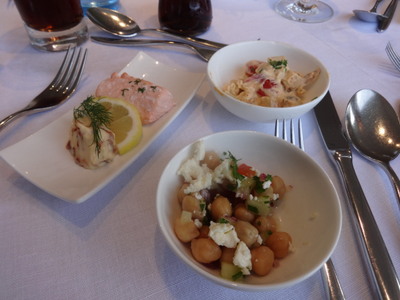
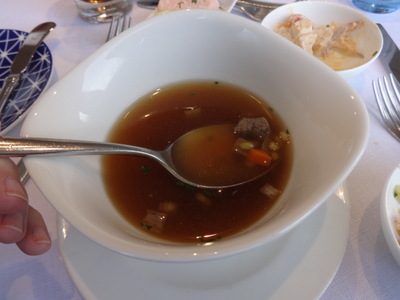 The "fine print" appetizers of the day were very good—a chick pea salad with feta, a little potato salad, and an outstanding small piece of cold poached salmon.
The "fine print" appetizers of the day were very good—a chick pea salad with feta, a little potato salad, and an outstanding small piece of cold poached salmon.
The soup was pretty good beef and barley.
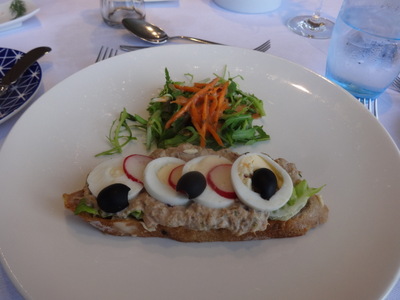
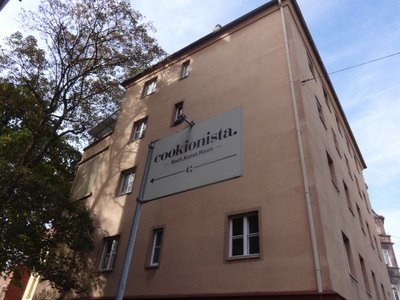 The main course, "Mediterranean tuna toast," was not such a much. I should have gone for the roast turkey medallions.
The main course, "Mediterranean tuna toast," was not such a much. I should have gone for the roast turkey medallions.
I don't seem to have gotten a photo of dessert, but knowing me, I probably had the café Liègoise (ice cream with coffee syrup).
Then about eight of us were off in the buses again, with guide/chef Markus and driver Dieter, for "History and Flavors of Nuremberg." Our first stop was at this cooking school, which, rather too cutely, called itself "Cookionista."
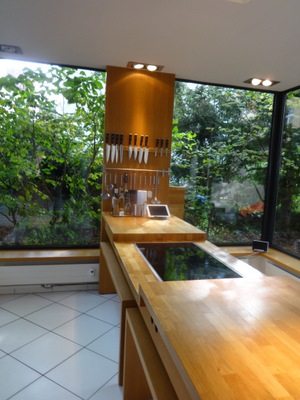
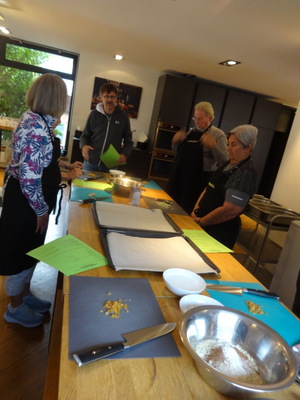 The place was certainly beautiful. At the left here is one of their teaching counters, with the leaves slid open in the center to reveal a smooth ceramic cooktop. Impressive array of knives on a magnetic strip at the far end.
The place was certainly beautiful. At the left here is one of their teaching counters, with the leaves slid open in the center to reveal a smooth ceramic cooktop. Impressive array of knives on a magnetic strip at the far end.
We wouldn't be using the cooktop, so we used this counter, slid closed. You can see that it's set up for two groups of four.
We were here to make Lebkuchen, always translated "gingerbread." I have long since learned that French "gingerbread" is nothing whatever like American "gingerbread" (either the cake or the cookie) and doesn't even contain ginger. Here I learned that German "gingerbread" is nothing whatever like either one; at least it does contain some ginger. The kind we made was specificall "Elisen" (Elizabeth's) gingerbread, which is flourless and gluten free. The Elizabeth in question is thought to have been a baker's daughter who was the first recorded case of a gluten allergy.
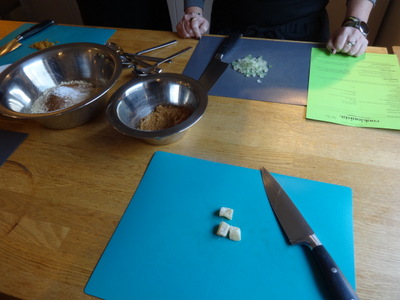
 The chef provided two recipes for it, differing mainly in that one called for three kinds of nuts and the other (which we used) only for almonds. Everything was measured out for us in advance: chopped almonds, ground almonds, candied lemon and orange peels, candied ginger, a pinch of baking soda, gingerbred spice mix, an egg, and brown sugar.
The chef provided two recipes for it, differing mainly in that one called for three kinds of nuts and the other (which we used) only for almonds. Everything was measured out for us in advance: chopped almonds, ground almonds, candied lemon and orange peels, candied ginger, a pinch of baking soda, gingerbred spice mix, an egg, and brown sugar.
At the left is the ginger, which I got to chop. The spice mix, which came in this tin, was a mixture of cinnamon, allspice, cardamom, coriander, clove, and nutmeg, all ground. I have the actual recipe, complete with the quantities, etc., so let me know if you'd like it.
Also provided was a package of what the chef called "Christmas wafers," yet another use for communion wafers. Of course, they contain gluten, so the chef explained that if we really wanted gluten-free lebkuchen, we should make it directly on parchment paper, without the wafers, but we went ahead and used them.
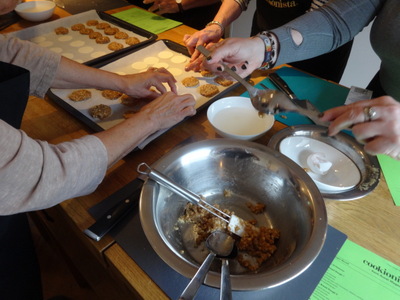
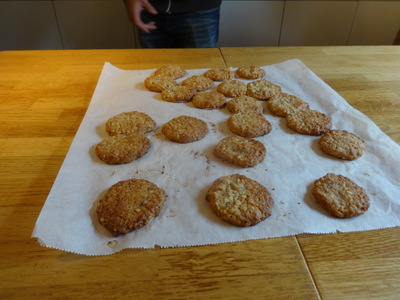 So we mixed everything up according to the instructions (I got to crack the egg). At the left here members of my group are shaping the dough into little round cookies on top of the wafers.
So we mixed everything up according to the instructions (I got to crack the egg). At the left here members of my group are shaping the dough into little round cookies on top of the wafers.
The chef them baked them up for us in his professional-grade confection ovens (180
The chef explained that they are usually iced with chocolate or lemon icing (he included the recipes) and that you can replace the orange or lemon in the recipe with, e.g., dried cranberries. I don't think they needed icing either fresh or a day older.
While the cookies baked, Markus told us what it took for him to become a chef. For three years, he spent 3 days a week working in a restaurant kitchen ang the other two in school. He was limited to an 8-hour day (not sure if that's just for chefs or for all workers in Germany). In times of rush, you could be asked to put in up to 2 hours overtime, but then you have to have 12 hours off before you come back. At the end of that 3 years, you have 4 hous to make a 3-course dinner. They used to tell you a month in advance what you had to cook, but now when you show up for the exam you find out the menu. Marakus he had to cook fish and asparagus. He had 10 minutes to consult a cookbook, then had to start in. For dessert, he chose to make a yeast-based cherry cake, and it was a complete disaster. But he successfully made ririver salmon with turned potatoes. The first course was asparagus in a tomato vinaigrette. Once you pass, you work for 1 year elsewhere. Markus then worked in big hotels before he came here to the cooking school.
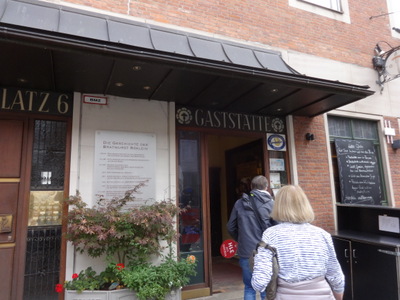
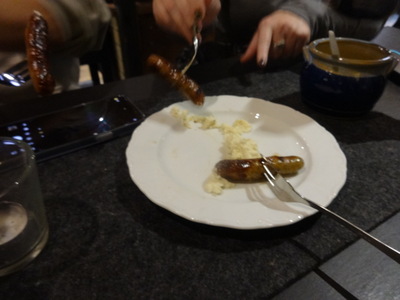 But Lebkuchen are not the only flavor of Nuremburg. Our next stop was this famous sausage restaurant, with the lid of an old beer tank over the bar, where we were served the famous skinny Nuremberg bratwurst, with the requisite horseradish-not-mustard.
But Lebkuchen are not the only flavor of Nuremburg. Our next stop was this famous sausage restaurant, with the lid of an old beer tank over the bar, where we were served the famous skinny Nuremberg bratwurst, with the requisite horseradish-not-mustard.
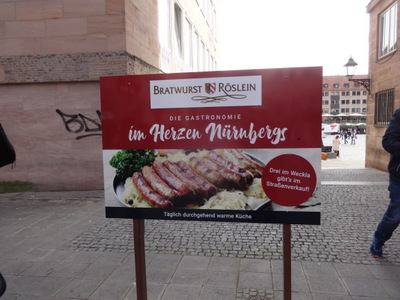
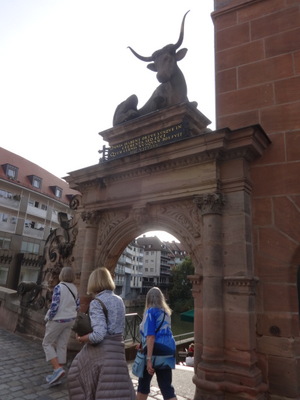 Here's the restaurant's sign, portraying bratwurst (of course) on a bed of sauerkraut.
Here's the restaurant's sign, portraying bratwurst (of course) on a bed of sauerkraut.
At the right is a view of the 1958 restoration of the 1599 "ox portal," the entrance to the meat market that was destroyed in WWII. The nearby arched meat bridge (a bridge with no central pylon and just one arch) has its own historic marker and and was recently renovated.
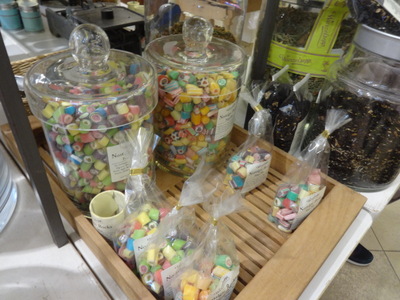
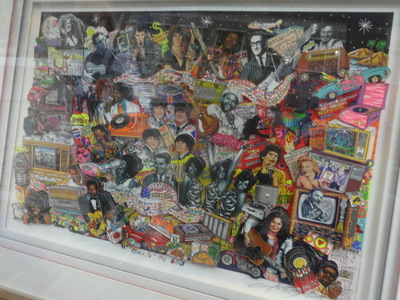 We visited several stores selling candy, spices, macarons, and many, many variations on "gingerbread," as well as toys, souvenirs, and "pop art," but I did not buy any. Viking feeds us very well as it is, and David would be annoyed if I brought home any pop art!
We visited several stores selling candy, spices, macarons, and many, many variations on "gingerbread," as well as toys, souvenirs, and "pop art," but I did not buy any. Viking feeds us very well as it is, and David would be annoyed if I brought home any pop art!
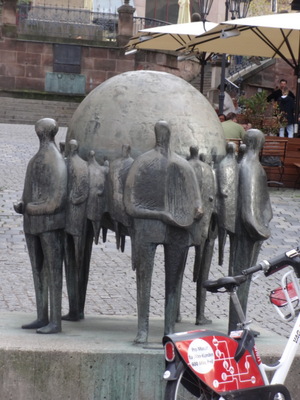
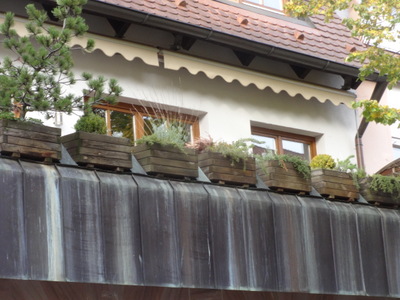 As we strolled around, we passed this nice bronze monument that, unfortunately, I have been unable to identify. It's apparently not significant enough for Google to consider it a "globe (or sphere or bronze or round) monument in nuremberg," but I liked it.
As we strolled around, we passed this nice bronze monument that, unfortunately, I have been unable to identify. It's apparently not significant enough for Google to consider it a "globe (or sphere or bronze or round) monument in nuremberg," but I liked it.
At the right is a fabulous set of windowboxes lining somebody's second-floor terrace. Gorgeous.
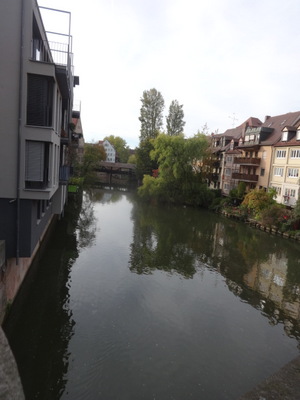
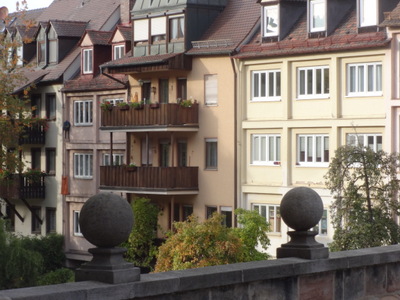 As we strolled around the old town, window shopping and admiring the view from the many little bridges over the river (the Pegnitz, not the Danube), Markus continued to fill us in on local history and lore.
As we strolled around the old town, window shopping and admiring the view from the many little bridges over the river (the Pegnitz, not the Danube), Markus continued to fill us in on local history and lore.
- The space below the walls was at one time a zoo (Tiergarden, actually a wild game park for patrician hunters), so the gate tower where we walked into the city (both this morning and this afternoon) is called the Tiergartentoor.
- In old times, the city gates closed at 10 pm, and you had to be inside.
- When the stone masons made building stones, they scratched a number on each one, to show how many they had made in the day, and they were paid accordingly.
- the meat and fruit markets were on the north side of the market square and the bread market on on the south side. The rich people could come to the south side, but the poor people could not go to the north side for the meat and fruit.
- All the exteriors and buildings for the new live-action Pinocchio were filmed here.
- Nuremberg bratwurst can only be made in Nuremerg (Franconian bratwurst is larger) and is served with an oil and vinegar potato salad with hot butter and/or sauerkraut.
- The beer is made in oak barrels.
- Nuremberg has the largest Christmas market in the world, and partner cities have smaller ones.
- Kaizerstrasse is where all the high-end shops are.
- Wiesn is what Octoberfest is called around here; wiesn is a variant of wiese, which means lawn, meadow, or fairgrounds.
- Franconian wine bottles are shaped like Mateus bottles and are dark green. We saw a whole collection of empties hanging next to someone's door. Probably antique ones, as they had that irregular, hand-made look.
- Germany puts $9 billion/year into the pool to be split with other countries (the EU, presumably).
- The city as 80,000 inhabitants, is built on 7 hills (why always 7?), and produces something called smoked beer.
- Orlando Bloom's Three Musketeers was filmed there.

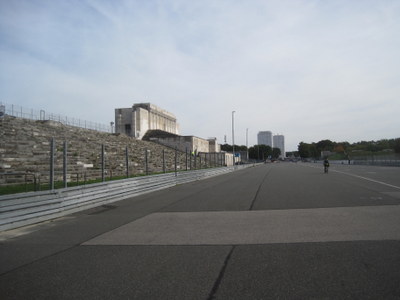 Meanwhile, David was off learning about Nuremburg in WWII. These two photos are of the infamous Nazi party rally grounds, southeast of the city. It's a huge complex covering 11 square miles, and half a dozen major party rallies were held there in the years leading up to the war. Had its own train station and everything.
Meanwhile, David was off learning about Nuremburg in WWII. These two photos are of the infamous Nazi party rally grounds, southeast of the city. It's a huge complex covering 11 square miles, and half a dozen major party rallies were held there in the years leading up to the war. Had its own train station and everything.
Some portions were damaged in the war and later demolished, but these grandstands remain.
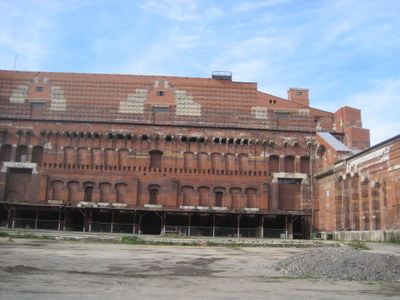
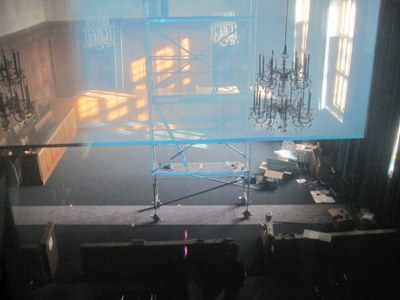 At the left is (a very small part of) the congress hall on the rally grounds (built of 42 million bricks!).
At the left is (a very small part of) the congress hall on the rally grounds (built of 42 million bricks!).
At the right is a view down into the courtroom where the warm-crimes tribunals took place. They weren't able to go in because it was under renovation, but they could see it from above through this window.
We all had to be back on board by 6:45 pm, when the ship cast off once again. As usual, we were offered drinks and live music in the lounge before dinner, as well as a briefing on the next day's activities.
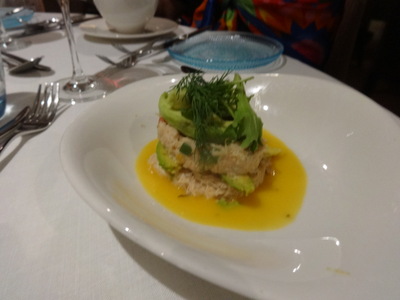
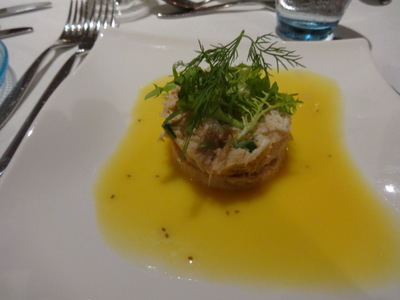 The best appetizer at dinner was crab salad with grapefruit, avocado, and citrus emulsion, but our trusty maitre d' had already alerted the kitchen, so they were prepared to make one for me without the avocado if that's what I wanted. Yes, please!
The best appetizer at dinner was crab salad with grapefruit, avocado, and citrus emulsion, but our trusty maitre d' had already alerted the kitchen, so they were prepared to make one for me without the avocado if that's what I wanted. Yes, please!
At the left here is the standard preparation, and at the right the one they made for me by simply omitting the avocado layers.
The main course was "Faux filet au Roquefort"—New York strip with Roquefort cheese sauce. Okay, but if I was just going to have steak for dinner, why not go for the cut I prefer? So I ordered the ribeye off the "always available" menu instead. Yummy.
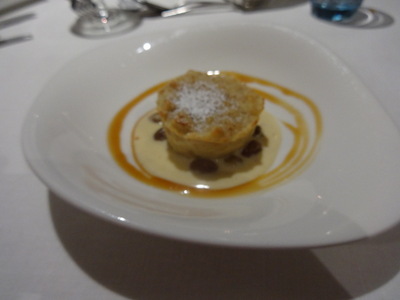
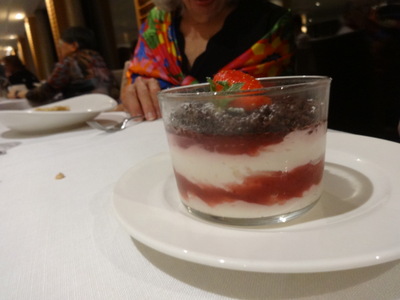 At the left here is the bread and butter pudding with rum raisin sauce. Also yummy.
At the left here is the bread and butter pudding with rum raisin sauce. Also yummy.
Somebody else ordered the "regional" dessert, billed as German curd cream mousse, which turned out to be this parfait-like structure with berries.
Finally, in the evening we were treated to live regional music, this time from a trio calling themselves (in Yiddish) Three Handsome Guys—not quite klezmer, but rousing nonetheless!
Previous entry List of Entries Next entry